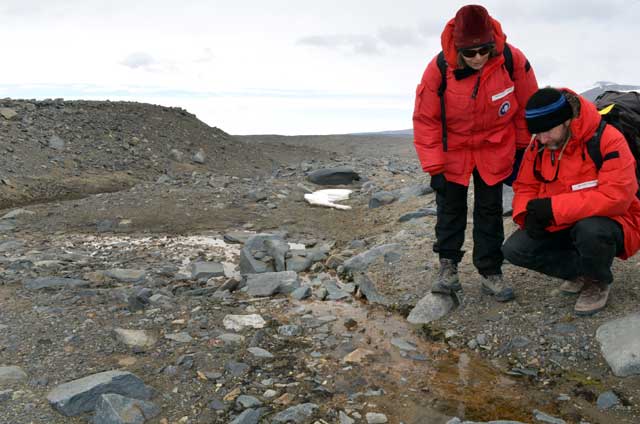|
Ongoing experimentMcMurdo LTER program marks 20 years of groundbreaking researchPosted September 27, 2013
Scientists Diane McKnight and Jeb Barrett White coolers are staked down across the incline, as if set up for a beach party, but without the sand, sun and warm weather. Aside from the 1,000-gallon water tank at the top of the slope, the coolers are the most visible sign of the latest experiment by the McMurdo Dry Valleys Long Term Ecological Research (LTER) The so-called P3 experiment is intended to forecast what might happen to the soil ecosystem when the Dry Valleys grow wetter in the coming decades, if predictions about the effects of climate change in this region of Antarctica hold true. 
Photo Credit: Peter Rejcek
Scientists Diane McKnight, left, and Jeb Barrett check on an experiment monitoring bacterial mats in Green Creek, Taylor Valley.
“This experiment is probably one of the larger experiments we’ve made in the soil environments,” says Barrett, associate professor of biological sciences at Virginia Tech That statement comes during a milestone moment in the history of the McMurdo LTER, which completed its 20th year of observations during the 2012-13 summer season. It is one of 25 LTER sites The Dry Valleys is a polar desert slightly larger than Rhode Island in a continent about the size of the United State and Mexico combined. At 4,800 square kilometers, it is the largest ice-free zone in Antarctica, which boasts ice sheets up to five kilometers thick that could raise sea level more than 200 meters if it all melted. Briton Capt. Robert Falcon Scott and his team made the first exploration of the Dry Valleys 110 years ago, declaring Taylor Valley the “valley of the dead.” Four young New Zealand scientists, led by the late Colin Bull, were the first researchers to study the valleys in the 1950s. [See previous article — Groundbreaking Study: New book details first university-sponsored expedition to Antarctica.] By the late 1980s, U.S. scientists and colleagues were making interesting observations. They watched the lake levels rapidly rise in a few weeks one summer and then decline the next, as the region bucked the global trend of overall warming. They pitched the idea of an LTER site in the Dry Valleys by 1990, 10 years after the NSF established the LTER network. “We could see the lakes coming up. We could see lake-level rise. We were extremely keen because we could see the changes happening in front of our eyes,” says McKnight, a professor at the University of Colorado in Boulder The first proposal failed, but a site across the continent off the Antarctic Peninsula was selected as an LTER program that year. The Palmer LTER A follow-up proposal two years later proved more successful for the McMurdo LTER. “We saw the LTER as an opportunity,” McKnight adds. SimpleThe opportunity offered by the Dry Valleys was one of tuning out noise – an ecosystem that strips out much of the color and complexity for a black and white picture that while still rich and beautiful, is simpler in terms of patterns. "We have a system where we can look at how a changing environment can change biodiversity."
“It’s one of the few places on the planet where we can pick up a handful of soil and pretty well characterize the entire soil biota,” explains Ross Virginia He and colleague Diana Wall at Colorado State University (CSU) Analysis of the polar dirt found that tiny invertebrates such as the worm-like nematodes lived in the soil – but in numbers and diversity far less than even the hot deserts where Virginia and Wall conducted fieldwork. The absence of plants and other flora also made the Dry Valleys an attractive laboratory where the relationships between cause and effect were much easier to tease out. “We have a system where we can look at how a changing environment can change biodiversity,” Virginia says. The organisms themselves have proven to be endlessly fascinating. One species of nematode, Scottnema linsayae, is well adapted to life in a polar dessert. It can spend a human lifetime coiled up in a freeze-dried state called anhydrobiosis, perking up with the addition of a little water. “We didn’t know that 20 years ago,” Wall notes. “We have a much better idea of their biogeography, a much better idea of their survival strategies. We know much more about how they contribute to carbon cycling and why they’re important in the Dry Valleys. And we can predict what may happen in the future.” |



For USAP Participants |
For The Public |
For Researchers and EducatorsContact UsU.S. National Science FoundationOffice of Polar Programs Geosciences Directorate 2415 Eisenhower Avenue, Suite W7100 Alexandria, VA 22314 Sign up for the NSF Office of Polar Programs newsletter and events. Feedback Form |



